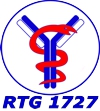MD TP68: Elucidating the mechanisms of IL-10 production in plasma cells
Epidermolysis bullosa acquisita (EBA) is an autoantibody driven blistering dermatosis. Like many autoantibody-mediated disorders, the disease is difficult to treat. IL-10 producing plasma cells formed in the natural course of murine EBA can limit EBA skin inflammation. Strikingly, our previous work shows that in vivo stimulation of the B cell receptor (BCR) IgD induces IL-10+ plasma cells which induce Tregs, suppress inflammatory T cells and inhibit neutrophil functions and the effector phase of murine EBA. Despite this success, it is still unclear how BCR signals integrate with co-stimulatory signals to initiate changes in cellular organization and cell metabolism that result in the formation of IL-10+plasma cells.
In order to address these questions we developed a construction kit that allows to stimulate B cells with various BCR signals strengths, via variable BCR-subclasses, including IgD, IgM and co-stimulators, either alone or in combination. This project aims to use this method to identify the signals required to induce IL-10 in plasma cells and to elucidate the underlying mechanism. In addition, the project is designed to optimize BCR-mediated induction of IL-10 in plasma cells for a therapeutic setting. Because plasma cells co-localize with potential target cells of IL-10 and provide local, rather than systemic, IL-10 mediated immune suppression, we expect that induction of IL-10+ plasma cells has less side effects and will be more long-lasting than treatment with IL-10 itself.

- Projects
- Projects
- Associated projects
- MD projects
- MD TP51 - Humanized mouse model for systemic sclerosis...
- MD TP63 - Investigating pemphigus vulgaris pathogenesis using a human skin organ culture model
- MD TP64 - Expression of C5aR1 and C5aR2 in skin biobsies of bullous pemphigus patients
- MD TP65 - Expression of AT1R, ETAR, CXCR3 and CXCR4 in lungs of ApoE knockout mice
- MD TP66 - Role of IL-13 in the pathogenesis of experimental systemic sclerosis
- MD TP67 - Experimental mouse model for Pemphigus vulgaris
- MD TP68 - Elucidating the mechanisms of IL-10 production in plasma cells
- MD TP69 - Establishment and utilization of a 3D-model of human skin for translational utilisation
- Associated MD projects
- Concluded projects






